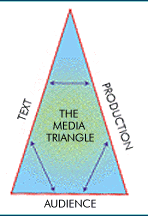Media Triangle
The Media Triangle below provides you with a checklist of questions for deconstructing media texts. The triangle starts from the assumption that each media text is produced in a particular way, for a particular audience. (To print this document: print horizontally)
| TEXT
1. In what ways does this text tell a story? Does it connect to a larger story? |
|
PRODUCTION
1. Where does this text come from? Who created it? |
|
AUDIENCE 1. How does this text appeal to me? What things do I like and dislike? |
The model above was developed by Eddie Dick, Media Education Officer for the Scottish Film Council. “The model stresses analysis and practice within a cultural, political, and economic milieu. The audience component of the model acknowledges the current research emphasis on audience response theory and the active use of media by the audience. The production component examines who produces media, and how it is distributed, as well as the technical, economic and legal issues at work in producing media products. The text component reveals intended meaning and other, more hidden, meanings as well as genre, values, narrative and issues which cue the meaning of media content. The Scots also place an emphasis on production, beginning at an early age.” (Reprinted from Strategies, The Strategies for Media Literacy Inc Quarterly, summer 1989
